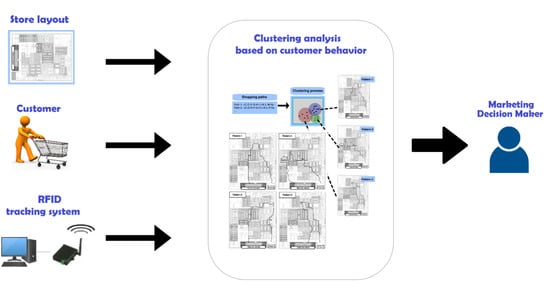Customer Purchasing Behavior Analysis as Alternatives for Supporting In-Store Green Marketing Decision-Making
Abstract
:1. Introduction
2. Background Studies
2.1. Literature Review
2.2. Green Purchasing
2.3. Green Marketing
2.4. Sustainability in Retailing
2.5. Customers’ Purchasing Behaviors
2.6. Clustering Analysis for Decision-Making
3. Methodology
3.1. Criteria for Decision Alternatives
3.2. RFID Systems for Collecting Customers’ Purchasing Patterns
3.3. Dataset
3.4. Grouping Customers’ Shopping Patterns
4. Results and Discussion
4.1. Clustering Analysis by Shopping Time
4.1.1. Short Group
4.1.2. Medium Group
4.1.3. Long Group
4.2. Profiling Customers’ Shopping Patterns
4.2.1. Green Products Recommendations
4.2.2. Analysis of Store Traffic and Location of Green Products
5. Conclusions
Acknowledgments
Author Contributions
Conflicts of Interest
References
- Chen, T.B.; Chai, L.T. Attitude towards the environment and green products: Consumers’ perspective. Manag. Sci. Eng. 2010, 4, 27–39. [Google Scholar]
- Crane, A.; Desmond, J. Societal marketing and morality. Eur. J. Mark. 2002, 36, 548–569. [Google Scholar] [CrossRef]
- Joshi, Y.; Rahman, Z. Factors affecting green purchase behaviour and future research directions. Int. Strateg. Manag. Rev. 2015, 3, 128–143. [Google Scholar] [CrossRef]
- Lozano, R.; Huisingh, D. Inter-linking issues and dimensions in sustainability reporting. J. Clean. Prod. 2011, 12, 99–107. [Google Scholar] [CrossRef]
- Murin, I.; Marková, I.; Zelený, J.; Jaďuďová, J. Green marketing as a tool influencing consumers’ behavior: Slovak case study of regional mark preference. Proc. Econ. Financ. 2015, 34, 260–267. [Google Scholar]
- Chen, J.; Cheng, J.; Dai, S. Regional eco-innovation in China: An analysis of eco-innovation levels and influencing factors. J. Clean. Prod. 2017, 153, 1–14. [Google Scholar] [CrossRef]
- Veleva, V.; Ellenbecker, M. Indicators of sustainable production: Framework and methodology. J. Clean. Prod. 2001, 9, 519–549. [Google Scholar] [CrossRef]
- McCarthy, B.; Liu, H.B. Food waste and the ‘green’ consumer. Aust. Mark. J. 2017, 25, 126–132. [Google Scholar] [CrossRef]
- Moisander, J. Motivational complexity of green consumerism. Int. J. Consum. Stud. 2007, 31, 404–409. [Google Scholar] [CrossRef]
- Applebaum, W. Studying customer behavior in retail stores. J. Mark. 1951, 16, 172–178. [Google Scholar] [CrossRef]
- Grunert, S.C.; Juhl, H.J. Values, environmental attitudes, and buying of organic foods. J. Econ. Psychol. 1995, 16, 39–62. [Google Scholar] [CrossRef]
- Wilkinson, J.B.; Mason, J.B.; Paksoy, C.H. Assessing the impact of short-term supermarket strategy variables. J. Market. Res. 1982, 19, 72–86. [Google Scholar] [CrossRef]
- Tendai, M.; Crispen, C. In-store shopping environment and impulsive buying. Afr. J. Mark. Manag. 2009, 1, 102–108. [Google Scholar]
- Schultz, D.E.; Block, M.P. How U.S. consumers view in-store promotions. J. Bus. Res. 2011, 64, 51–54. [Google Scholar] [CrossRef]
- Zhou, L.; Wong, A. Consumer impulse buying and in-store stimuli in Chinese supermarkets. J. Int. Consum. Mark. 2004, 16, 37–53. [Google Scholar] [CrossRef]
- Epstein, L.; Flores, A.; Goodstein, R.; Milberg, J. A new approach to measuring retail promotion effectiveness: A case of store traffic. J. Bus. Res. 2016, 69, 4394–4402. [Google Scholar] [CrossRef]
- Lam, S.Y.; Vandenbosch, M.; Hulland, J.; Pearce, M. Evaluating promotions in shopping environments: Decomposing sales response into attraction, conversion, and spending effects. Mark. Sci. 2001, 20, 194–215. [Google Scholar] [CrossRef]
- Newman, A.; Yu, D.; Oulton, D. New insights into retail space and format planning from customer-tracking data. J. Retail. Cusum. Serv. 2002, 9, 254–258. [Google Scholar] [CrossRef]
- Larson, J.; Bradlow, E.; Fader, P. An exploratory look at supermarket shopping paths. Int. J. Res. Market. 2005, 22, 359–414. [Google Scholar] [CrossRef]
- Pride, W.M.; Ferrell, O.C. Marketing, 8th ed.; Houghton Mifflin: Boston, MA, USA, 1993. [Google Scholar]
- Welford, R. Hijacking Environmentalism; Earthscan: London, UK, 2000. [Google Scholar]
- Hasan, Z.; Ali, N.A. The impact of green marketing strategy on the firm’s performance in Malaysia. Proc. Soc. Behav. Sci. 2015, 172, 463–470. [Google Scholar] [CrossRef]
- Porter, M.E. America’s green strategy. Sci. Am. 1991, 264, 96. [Google Scholar]
- Kangun, N.; Carlson, L.; Grove, S.J. Environmental advertising claims: A preliminary investigation. J. Publ. Police Mark. 1991, 10, 47–58. [Google Scholar]
- Lampe, M.; Gazda, G.M. Green marketing in Europe and the United States: An evolving business and society interface. Int. Bus. Rev. 1995, 4, 295–312. [Google Scholar] [CrossRef]
- Bohlen, G.; Diamantopolous, A.; Schlegeimilch, B. Consumer perceptions of the environmental impact of any industrial service. Mark. Intell. Plan. 1993, 11, 37–48. [Google Scholar] [CrossRef]
- Peattie, K.; Crane, A. Green marketing: Legend, myth, farce or prophesy? Qual. Mark. Res. Int. J. 2005, 8, 357–370. [Google Scholar] [CrossRef]
- Polonsky, M.J. An introduction to green marketing. Electron. Green J. 1994, 1, 1–10. [Google Scholar]
- Rex, E.; Baumann, H. Beyond ecolabels: What green marketing can learn from conventional marketing. J. Clean. Prod. 2007, 15, 567–576. [Google Scholar] [CrossRef]
- Ginsberg, J.M.; Bloom, P.N. Choosing the right green marketing strategy. MIT Sloan Manag. Rev. 2004, 46, 79–84. [Google Scholar]
- Laroche, M.; Bergeron, J.; Barbaro-Forleo, G. Targeting consumers who are willing to pay more for environmentally friendly products. J. Consum. Mark. 2001, 18, 503–520. [Google Scholar] [CrossRef]
- Lee, S.; Cho, Y.; Kim, S. Collaborative filtering with ordinal scale-based implicit ratings for mobile music recommendations. Inf. Sci. 2010, 180, 2142–2155. [Google Scholar] [CrossRef]
- Johri, L.M.; Sahasakmontri, K. Green marketing of cosmetics and toiletries in Thailand. J. Consum. Mark. 1998, 15, 265–281. [Google Scholar] [CrossRef]
- Teisl, M.F.; Roe, B.; Hicks, R.L. Can eco-labels tune a market? Evidence from dolphin-safe labeling. J. Environ. Econ. Manag. 2002, 43, 339–359. [Google Scholar] [CrossRef]
- Polonsky, M.J.; Rosenberger, P. Re-evaluating green marketing: A strategic approach. Bus. Horiz. 2001, 44, 21–30. [Google Scholar] [CrossRef]
- Rivera-Camino, J. Re-evaluating green marketing strategy: A stakeholder perspective. Eur. J. Mark. 2007, 41, 1328–1358. [Google Scholar] [CrossRef] [Green Version]
- D’Souza, C.; Taghian, M.; Lamb, P. An empirical study on the influence of environmental labels on consumers. Corp. Commun. Int. J. 2006, 11, 162–173. [Google Scholar] [CrossRef]
- Jones, P.; Comfort, D.; Hillier, D. What’s in store? Retail marketing and corporate social responsibility. Mark. Intell. Plan. 2007, 25, 17–30. [Google Scholar] [CrossRef]
- Menon, A.; Menon, A. Enviropreneurial marketing strategy: The emergence of corporate environmentalism as market strategy. J. Market. 1997, 61, 51–67. [Google Scholar] [CrossRef]
- Hunt, S.D.; Morgan, R.M. The resource advantage theory of competition: Dynamics, path dependencies, and evolutionary dimensions. J. Mark. 1996, 60, 107–114. [Google Scholar] [CrossRef]
- Hunt, S.D.; Morgan, R.M. The comparative advantage theory of competition. J. Mark. 1995, 59, 1–14. [Google Scholar] [CrossRef]
- Ko, E.; Hwang, Y.K.; Kim, E.Y. Green marketing’ functions in building corporate image in the retail setting. J. Bus. Res. 2013, 66, 1709–1715. [Google Scholar] [CrossRef]
- Kumar, P. Greening retail: An Indian experience. Int. J. Retail Distrib. Manag. 2014, 42, 613–625. [Google Scholar] [CrossRef]
- Chan, R.Y. Determinants of Chinese consumers’ green purchase behavior. Psychol. Market. 2001, 18, 389–413. [Google Scholar] [CrossRef]
- Chekima, B.; Syed Khalid Wafa, S.A.W.; Igau, O.A.; Chekima, S.; Sondoh, S.L., Jr. Examining green consumerism motivational drivers: Does premium price and demographics matter to green purchasing? J. Clean. Prod. 2016, 112, 3436–3450. [Google Scholar] [CrossRef]
- Lin, P.C.; Huang, Y.H. The influence factors on choice behavior regarding green products based on the theory of consumption values. J. Clean. Prod. 2012, 22, 11–18. [Google Scholar] [CrossRef]
- Yook, K.H.; Choi, J.H.; Suresh, N.C. Linking green purchasing capabilities to environmental and economic performance: The moderating role of firm size. J. Purch. Supply Manag. 2017. [Google Scholar] [CrossRef]
- Ramayah, T.; Lee, J.W.C.; Mohamad, O. Green product purchase intention: Some insights from a developing country. Res. Conserv. Recycl. 2010, 54, 1419–1427. [Google Scholar] [CrossRef]
- Shamdasani, P.; Chon-Lin, G.; Richmond, D. Exploring green consumers in an oriental culture: Role of personal and marketing mix. Adv. Consum. Res. 1993, 20, 488–493. [Google Scholar]
- Connell, K.Y.H. Internal and external barriers to eco-conscious apparel acquisition. Int. J. Consum. Stud. 2010, 34, 279–286. [Google Scholar] [CrossRef]
- Vermeir, I.; Verbeke, W. Sustainable food consumption: Exploring the consumer “attitude–behavioral intention” gap. J. Agric. Environ. Ethics 2006, 19, 169–194. [Google Scholar] [CrossRef]
- Ajzen, I.; Fishbein, M. Understanding Attitudes and Predicting Social Behaviour; Prentice-Hall: Englewood Cliffs, NJ, USA, 1980. [Google Scholar]
- Ajzen, I. From intentions to actions: A theory of planned behavior. In Action Control from Cognition to Behavior; Springer: Berlin/Heidelberg, Germany, 1985. [Google Scholar]
- Arvola, A.; Vassallo, M.; Dean, M.; Lampila, P.; Saba, A.; Lähteenmäki, L.; Shepherd, R. Predicting intentions to purchase organic food: The role of affective and moral attitudes in the theory of planned behavior. Appetite 2008, 50, 443–454. [Google Scholar] [CrossRef] [PubMed]
- Taghian, C.D.M. Green advertising effects on attitude and choice of advertising themes. Asia Pac. J. Mark. Logist. 2005, 17, 51–66. [Google Scholar]
- Polonsky, M.J. A stake holder theory of approach to designing environmental marketing strategy. J. Bus. Ind. Mark. 1995, 10, 29–46. [Google Scholar] [CrossRef]
- Ottman, J. The New Rules of Green Marketing: Strategies, Tools and Inspiration for Sustainable Branding. Kindle e-Book; Berret-Koehler Publishers: Oakland, CA, USA, 2011; ISBN 978-1-60509-868-5. [Google Scholar]
- William, B.E.; Sinkula, J.M. Environmental strategy and firm performance: Effects on new product performance and market share. J. Acad. Mark. Sci. 2005, 33, 461–475. [Google Scholar]
- Silayoi, P.; Speece, M. Packaging and purchase decisions: An exploratory study on the impact of involvement level and time pressure. Br. Food J. 2004, 106, 607–628. [Google Scholar] [CrossRef]
- Inman, J.J.; Winer, R.S.; Ferraro, R. The interplay among category characteristics, customer characteristics, and customer activities on in-store decision making. J. Mark. 2009, 73, 19–29. [Google Scholar] [CrossRef]
- Gauri, D.K.; Ratchford, B.; Pancras, J.; Talukdar, D. An empirical analysis of the impact of promotional discounts on store performance. J. Retail. 2017, 93, 283–303. [Google Scholar] [CrossRef]
- Janakiraman, N.; Meyer, R.J.; Morales, A.C. Spillover effects: How consumers respond to unexpected changes in price and quality. J. Consum. Res. 2006, 33, 361–369. [Google Scholar] [CrossRef]
- Heilman, C.M.; Nakamoto, K.; Rao, A.G. Pleasant surprises: Consumer response to unexpected in-store coupons. J. Mark. Res. 2002, 39, 242–245. [Google Scholar] [CrossRef]
- Barnes, L.; Lea-Greenwood, G. Fast fashion in the retail store environment. Int. J. Retail. Distrib. Manag. 2010, 38, 760–772. [Google Scholar] [CrossRef]
- Nancarrow, C.; Wright, L.T.; Brace, I. Gaining competitive advantage from packaging and labeling in marketing communications. Br. Food J. 1998, 100, 110–118. [Google Scholar] [CrossRef]
- Ailawadi, K.L.; Beauchamp, J.P.; Donthu, N.; Gauri, D.K.; Shankar, V. Communication and promotion decisions in retailing: A review and directions for future research. J. Retail. 2009, 85, 42–55. [Google Scholar] [CrossRef]
- Chabowski, B.R.; Mena, J.A.; Gonzalez-Padron, T.L. The structure of sustainability research in marketing, 1958–2008: A basis for future research opportunities. J. Acad. Mark. Sci. 2011, 39, 55–70. [Google Scholar] [CrossRef]
- Nyilasy, G.; Gangadharbatla, H.; Paladino, A. Perceived greenwashing: The interactive effects of green advertising and corporate environmental performance on consumer reactions. J. Bus. Ethics 2013, 125, 693–707. [Google Scholar] [CrossRef]
- Shankar, V.; Inman, J.; Kelly, E.; Mantrala, M.; Rizley, R. Innovations in shopper marketing. J. Retail. 2011, 87, S29–S42. [Google Scholar] [CrossRef]
- McDaniel, S.W.; Rylander, D.H. Strategic green marketing. J. Consum. Mark. 1993, 10, 4–10. [Google Scholar] [CrossRef]
- Kennedy, A.M.; Kapitan, S.; Soo, M. Eco-warriors: Shifting sustainable retail strategy via authentic retail brand image. Aust. Mark. J. 2016, 24, 125–134. [Google Scholar] [CrossRef]
- Steenis, N.D.; van Herpen, E.; van der Lans, I.A.; Ligthart, T.N.; van Trijp, H.C.M. Consumer response to packaging design: The role of packaging materials and graphics in sustainability perceptions and product evaluations. J. Clean. Prod. 2017, 162, 286–298. [Google Scholar] [CrossRef]
- Magnier, L.; Schoormans, J.; Mugge, R. Judging a product by its cover: Packaging sustainability and perceptions of quality in food products. Food Qual. Preference 2016, 53, 132–142. [Google Scholar] [CrossRef]
- Perrini, F.; Castaldo, S.; Misani, N.; Tencati, A. The impact of corporate social responsibility associations on trust in organic products marketed by mainstream retailers: A study of Italian consumers. Bus. Strategy Environ. Bus. 2010, 19, 512–526. [Google Scholar] [CrossRef]
- Jones, P.; Comfort, D.; Hillier, D. Corporate social responsibility as a means of marketing to and communicating with customers within stores: A case study of UK food retailers. Manag. Res. News 2005, 28, 47–56. [Google Scholar] [CrossRef]
- Chkanikova, O.; Mont, O. Corporate supply chain responsibility: Drivers and barriers for sustainable food retailing. Corp. Soc. Responsib. Environ. Manag. 2015, 22, 65–82. [Google Scholar] [CrossRef]
- Goworek, H.; Fisher, T.; Cooper, T.; Woodward, S.; Hiller, A. The sustainable clothing market: An evaluation of potential strategies for UK retailers. Int. J. Retail. Distrib. Manag. 2012, 40, 935–955. [Google Scholar] [CrossRef]
- Yang, S.; Song, Y.; Tong, S. Sustainable retailing in the fashion industry: A systematic literature review. Sustainability 2017, 9. [Google Scholar] [CrossRef]
- Jones, P.; Hillier, D.; Comfort, D.; Eastwood, I. Sustainable retailing and consumerism. Manag. Res. News 2005, 28, 34–44. [Google Scholar] [CrossRef]
- Lai, K.; Cheng, T.C.E.; Tang, A.K.Y. Green retailing: Factors for success. Calif. Manag. Rev. 2010, 52, 6–32. [Google Scholar] [CrossRef]
- Tang, A.K.Y.; Lai, K.-H.; Chen, T.C.E. Unleashing the value of green retailing. In Proceedings of the Retailing the Second POMS-HK International Conference, Hong Kong, China, 6–7 January 2011. [Google Scholar]
- Gunn, M.; Mont, O. Choice editing as a retailers’ tool for sustainable consumption. Int. J. Retail. Distrib. Manag. 2014, 42, 464–481. [Google Scholar] [CrossRef]
- Thaler, R.H.; Sustein, C.R. Nudge Improving Decisions about Health, Wealth, and Happiness; Yale University Press: New Haven, CT, USA, 2008. [Google Scholar]
- Anderson, E.W.; Fornell, C.; Lehmann, D. Customer satisfaction, market share, and profitability: Findings from Sweden. J. Mark. 1994, 58, 53–66. [Google Scholar] [CrossRef]
- Schiffman, L.G.; Kanuk, L.L. Consumer Behavior, 9th ed.; Prentice Hall: Upper Saddle River, NJ, USA, 2007. [Google Scholar]
- Kianpour, K.; Anvari, R.; Jusoh, A.; Othman, M.F. Important motivators for buying green products. Intang. Capitol. 2014, 10, 873–896. [Google Scholar] [CrossRef]
- Rani, P. Factors influencing consumer behavior. Int. J. Curr. Acad. Rev. 2014, 2, 52–61. [Google Scholar]
- Agrawal, S.; Srikant, R. Fast algorithms for mining association rules. In Proceedings of the 20th International Conference on Very Large Data Bases (VLDB ’94), San Francisco, CA, USA, 12–15 September 1994; pp. 487–499. [Google Scholar]
- Han, J.; Pei, J.; Yin, Y. Mining frequent patterns without candidate generation. In Proceedings of the 2000 ACM SIGMOD international conference on Management of data, Dallas, TX, USA, 15–18 May 2000; pp. 1–12. [Google Scholar]
- Dubey, A.K.; Shandilya, S. A novel J2ME service for mining incremental patterns in mobile computing. Commun. Comput. Inf. Sci. 2010, 101, 157–164. [Google Scholar]
- Chen, M.S.; Park, J.; Yu, P. Efficient data mining for path traversal patterns. IEEE Trans. Knowl. Data Eng. 1998, 10, 209–221. [Google Scholar] [CrossRef]
- Yun, C.H.; Chen, M.S. Using pattern-join and purchase combination for mining web transaction patterns in an electronic commerce environment. In Proceedings of the 2000 ACM SIGMOD International Conference on Management of Data, Dallas, TX, USA, 15–18 May 2000; pp. 99–104. [Google Scholar]
- Farley, J.; Ring, L. A stochastic model of supermarket traffic flow. Oper. Res. 1996, 14, 555–567. [Google Scholar] [CrossRef]
- Alexander, A.A.; Muhlebach, R.F. Shopping Centre Management; Institute of Real Estate Management: Chicago, IL, USA, 1992. [Google Scholar]
- Chandon, P.; Hutchinson, J.W.; Bradlow, E.T.; Young, S.H. Does in-store marketing work? Effects of the number and position of shelf facings on brand attention and evaluation at the point of purchase. J. Mark. 2009, 73, 1–17. [Google Scholar] [CrossRef]
- Uotila, V.; Skogster, P. Space management in a DIY store analyzing consumer shopping paths with data-tracking devices. Facilities 2007, 25, 363–374. [Google Scholar] [CrossRef]
- Parsons, A.J. Assessing the effectiveness of shopping mall promotions: Customer analysis. Int. J. Retail Distrib. Manag. 2003, 31, 74–79. [Google Scholar] [CrossRef]
- Hjort, K.; Lantz, B.; Ericsson, D.; Gattorna, J. Customer segmentation based on buying and returning behaviour. Int. J. Phys. Distrib. Logist. Manag. 2013, 43, 852–865. [Google Scholar] [CrossRef]
- Rezaei, J.; Ortt, R. Multi-criteria supplier segmentation using a fuzzy preference relations based AHP. Eur. J. Oper. Res. 2013, 225, 75–84. [Google Scholar] [CrossRef]
- Röthlisberger, V.; Zischg, A.P.; Keilera, M. Identifying spatial clusters of flood exposure to support decision making in risk management. Sci. Total Environ. 2017, 598, 593–603. [Google Scholar] [CrossRef] [PubMed]
- Liao, H.; Zhang, X. Hesitant Fuzzy Decision Making Methodologies and Applications; Springer: Berlin, Germany, 2016. [Google Scholar]
- Jain, A.K.; Murty, M.N.; Flynn, P.J. Data Clustering: A Review. ACM Comput. Surv. 1999, 31, 264–323. [Google Scholar] [CrossRef]
- Faber, V. Clustering and the Continuous K-means s algorithm. Los Alamos Sci. 1994, 22, 138–144. [Google Scholar]
- Faber, V.; Hochberg, J.G.; Kelly, P.M.; Thomas, T.R.; White, J.M. Concept extraction—A data-mining technique. Los Alamos Sci. 1994, 22, 122–149. [Google Scholar]
- Wu, Z.; Xu, J. A consensus model for large-scale group decision making with hesitant fuzzy information and changeable clusters. Inf. Fusion 2018, 41, 217–231. [Google Scholar] [CrossRef]
- Anderberg, M.R. Cluster Analysis for Applications; Academic Press, Inc.: Cambridge, MA, USA, 1973. [Google Scholar]
- Yoon, Y.; Hastak, M.; Choc, K. Preference clustering-based mediating group decision-making (PCM-GDM) method for infrastructure asset management. Exp. Syst. Appl. 2017, 83, 206–214. [Google Scholar] [CrossRef]
- Wang, E.; Alp, N.; Shi, J.; Wang, C.; Zhang, X.; Chen, H. Multi-criteria building energy performance benchmarking through variable clustering based compromise TOPSIS with objective entropy weighting. Energy 2017, 125, 197–210. [Google Scholar] [CrossRef]
- Delaney, R.; Strough, J.; Parker, A.M.; de Bruin, W.B. Variations in decision-making profiles by age and gender: A cluster-analytic approach. Personal. Individ. Differ. 2015, 85, 19–24. [Google Scholar] [CrossRef] [PubMed]
- Dolnicar, S. Using cluster analysis for market segmentation—Typical misconceptions, established methodological weaknesses and some recommendations for improvement. Australas. J. Mark. Res. 2003, 11, 5–12. [Google Scholar]
- Gattorna, J. Dynamic Supply Chains: Delivering Value through People, 2nd ed.; Pearson Education Limited: London, UK, 2010. [Google Scholar]
- Allenby, G.M.; Rossi, P. Marketing models of consumer heterogeneity. J. Econ. 1998, 89, 57–78. [Google Scholar] [CrossRef]
- Syaekhoni, M.A.; Lee, C.; Kwon, Y.S. Analyzing customer behavior from shopping path data using operation edit distance. Appl. Intell. 2016. [Google Scholar] [CrossRef]
- Rousseeuw, P. Silhouette: A graphical aid to the interpretation and validation of cluster analysis. J. Comput. Appl. Math. 1987, 20, 53–65. [Google Scholar] [CrossRef]
- Rokka, J.; Uusitalo, L. Preference for green packaging in consumer product choices—Do consumer’s care? Int. J. Consum. Stud. 2008, 32, 516–525. [Google Scholar] [CrossRef]
- Schwepker, C.H., Jr.; Cornwell, T.B. An examination of ecologically concerned consumers and their intention to purchase ecologically packaged products. J. Public Policy Mark. 1991, 10, 77–101. [Google Scholar]
- Levy, M.; Weitz, B.A. Retailing Management; McGraw-Hill/Irwin: New York, NY, USA, 2004. [Google Scholar]
- Terrazas, M. In-Store Displays that Work. The Baker, [Online]. 2006. Available online: http://www.thebaker.co.za (accessed on 5 August 2008).
- Michon, R.; Chebat, J.C.; Turley, L.W. Mall atmospherics: The interaction effects of the mall environment on shopping behavior. J. Bus. Res. 2005, 58, 576–583. [Google Scholar] [CrossRef]
- Salazar, H.A.; Oerlemans, L.; van Stroe-Biezen, S. Social influence on sustainable consumption: Evidence from a behavioural experiment. Int. J. Consum. Stud. 2013, 37, 172–180. [Google Scholar] [CrossRef]
- Hartmann, P.; Apaolaza-Ibáñez, V. Consumer attitude and purchase intention toward green energy brands: The roles of psychological benefits and environmental concern. J. Bus. Res. 2012, 65, 1254–1263. [Google Scholar] [CrossRef]
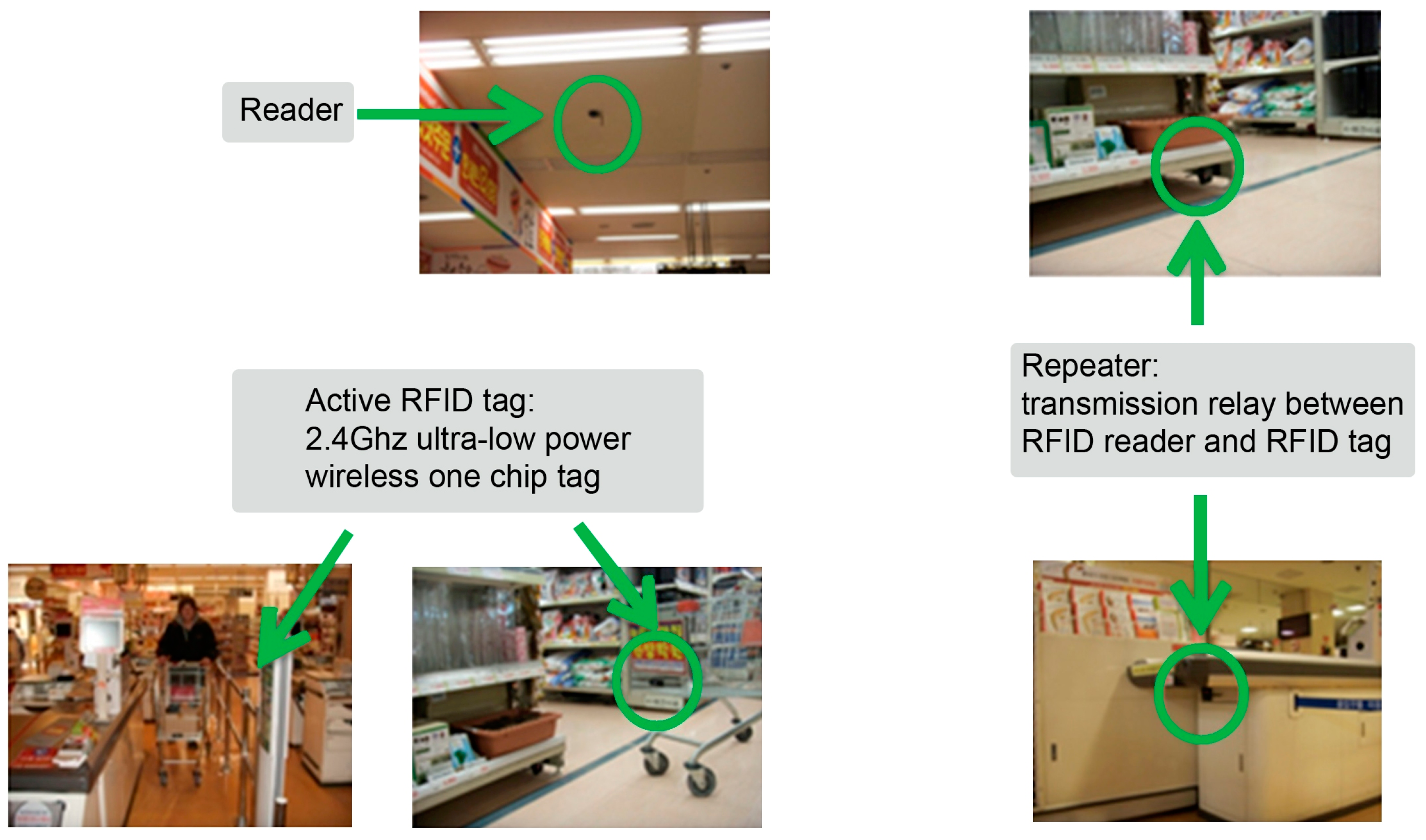
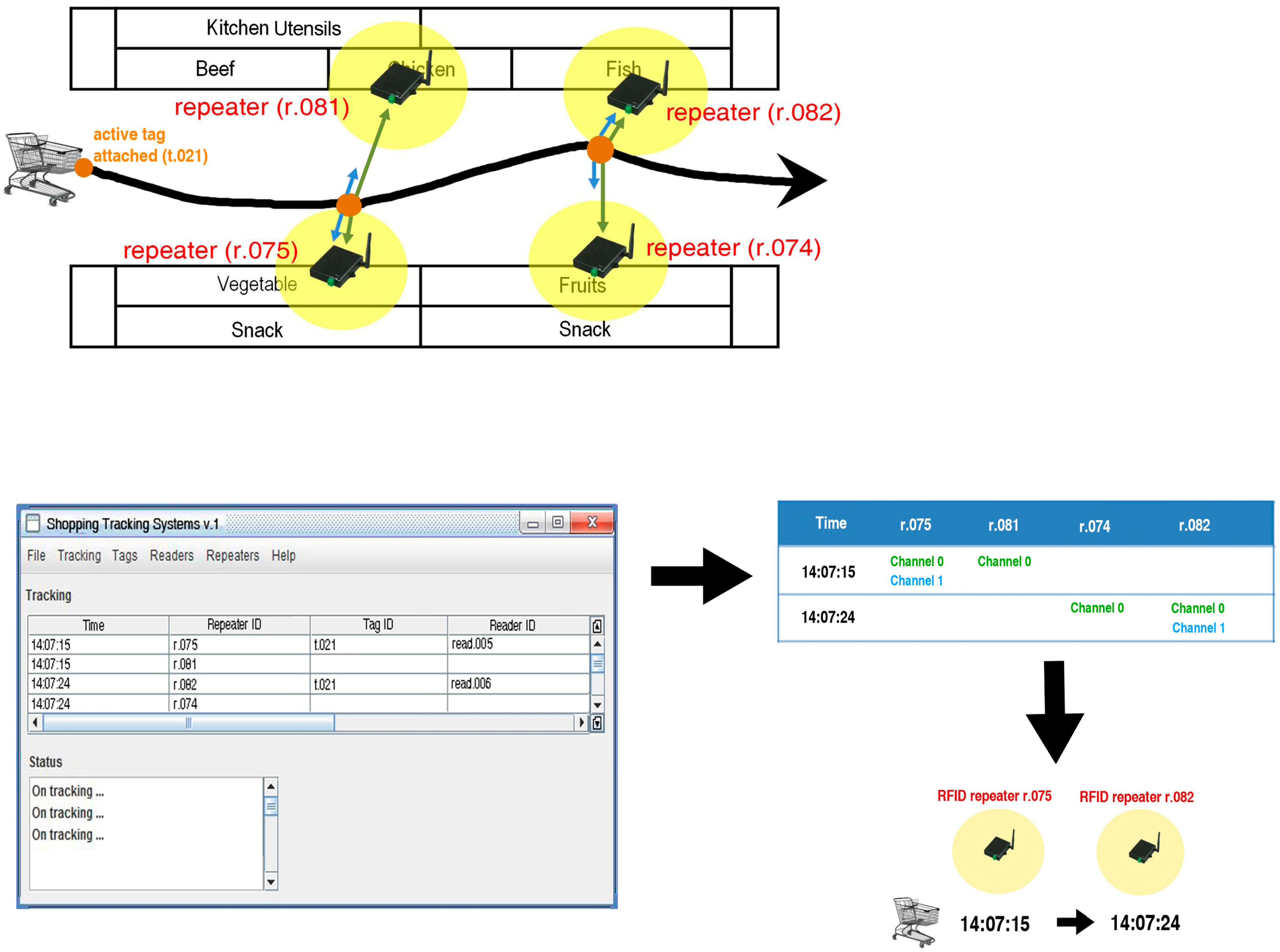






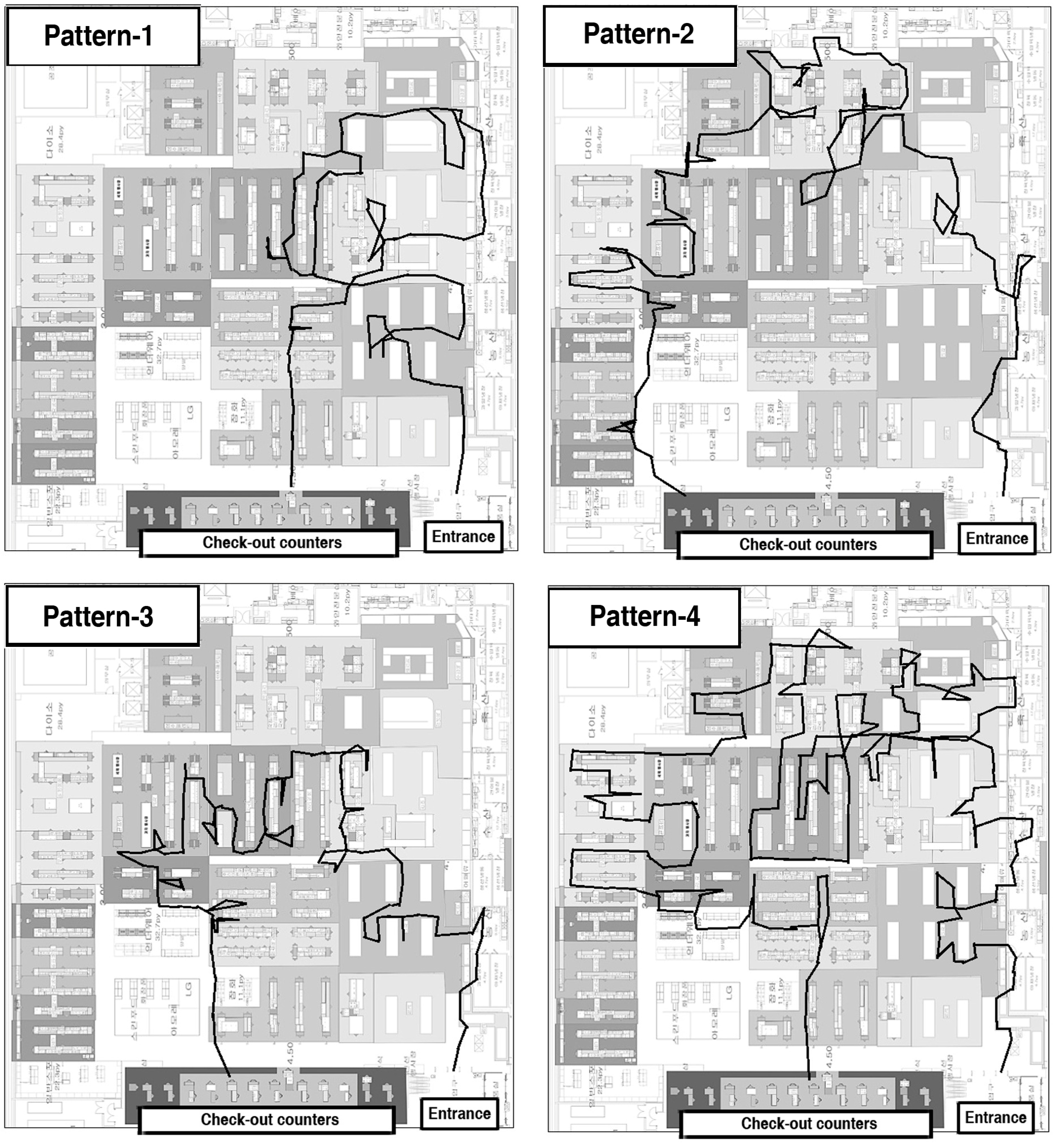
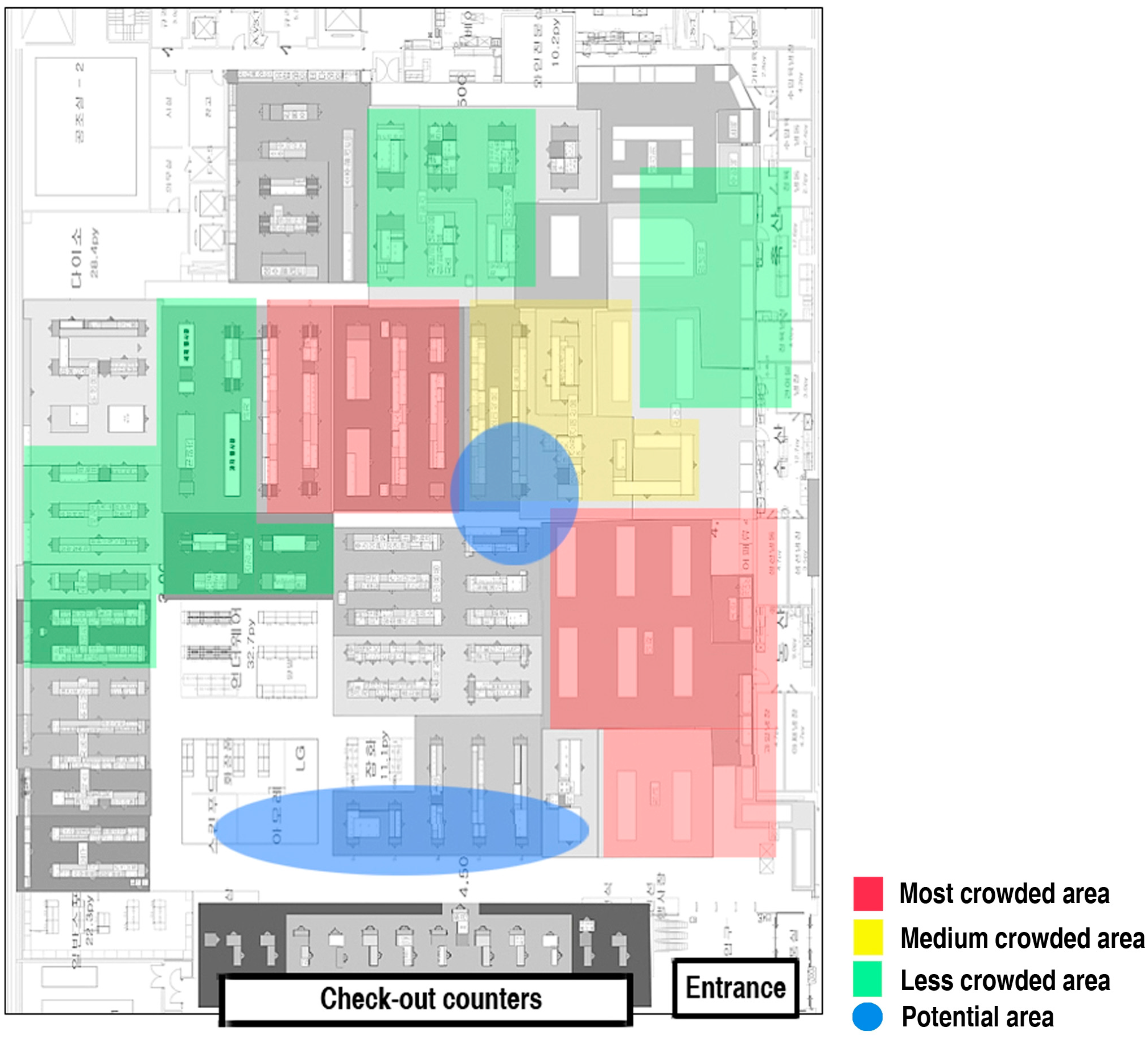
| Patterns | Size | Avg. Shopping Time (Min) | Avg. Lingering Time (S) | Avg. Sales (KRW) | Travel Direction | Avg. Product Purchased |
|---|---|---|---|---|---|---|
| Pattern 1 | 981 | 848 | 29.2 | 52,510 | Counter-clockwise | Groceries and snacks |
| Pattern 2 | 1290 | 843 | 25 | 51,211 | Counter-clockwise | Fruit, herbal tea and snacks |
| Pattern 3 | 1871 | 840 | 26.1 | 53,645 | Counter-clockwise | Agricultural products, dairy and fish |
| Pattern 4 | 1653 | 826 | 21.5 | 56,560 | Counter-clockwise | Vegetables, fruit, seafood and food seasoning |
| Patterns | Size | Avg. Shopping Time (Min) | Avg. Lingering Time (S) | Avg. Sales (KRW) | Travel Direction | Avg. Product Purchased |
|---|---|---|---|---|---|---|
| Pattern 1 | 1782 | 1697 | 28.3 | 58,756 | Counter-clockwise | Vegetables, snacks, cooked foods, instant foods |
| Pattern 2 | 1870 | 1707 | 34.7 | 65,277 | Counter-clockwise | Agricultural products, fish, meat |
| Pattern 3 | 1220 | 1703 | 25 | 57,305 | Counter-clockwise | Vegetables, snacks |
| Pattern 4 | 1097 | 1727 | 28.1 | 61,726 | Counter-clockwise | Vegetables, snacks |
| Pattern 5 | 1411 | 1709 | 37.8 | 62,805 | Clockwise | Vegetables, fruit, fish, dairy |
| Patterns | Size | Avg. Shopping Time (Min) | Avg. Lingering Time (S) | Avg. Sales (KRW) | Travel Direction | Avg. Product Purchased |
|---|---|---|---|---|---|---|
| Pattern 1 | 636 | 3220 | 36.2 | 70,506 | Clockwise | Vegetables, fruit, fish, dairy and food seasoning |
| Pattern 2 | 780 | 3130 | 27.2 | 69,611 | Counter-clockwise | Vegetables, fruit, dairy, snacks and beverages |
| Pattern 3 | 737 | 3295 | 26.4 | 65,595 | Counter-clockwise | Vegetables, dairy, snacks and cooked foods |
| Pattern 4 | 878 | 3156 | 40.8 | 65,718 | Counter-clockwise | Vegetables, snacks, dairy, fruit, cooked foods and fish |
© 2017 by the authors. Licensee MDPI, Basel, Switzerland. This article is an open access article distributed under the terms and conditions of the Creative Commons Attribution (CC BY) license (http://creativecommons.org/licenses/by/4.0/).
Share and Cite
Syaekhoni, M.A.; Alfian, G.; Kwon, Y.S. Customer Purchasing Behavior Analysis as Alternatives for Supporting In-Store Green Marketing Decision-Making. Sustainability 2017, 9, 2008. https://doi.org/10.3390/su9112008
Syaekhoni MA, Alfian G, Kwon YS. Customer Purchasing Behavior Analysis as Alternatives for Supporting In-Store Green Marketing Decision-Making. Sustainability. 2017; 9(11):2008. https://doi.org/10.3390/su9112008
Chicago/Turabian StyleSyaekhoni, M. Alex, Ganjar Alfian, and Young S. Kwon. 2017. "Customer Purchasing Behavior Analysis as Alternatives for Supporting In-Store Green Marketing Decision-Making" Sustainability 9, no. 11: 2008. https://doi.org/10.3390/su9112008





